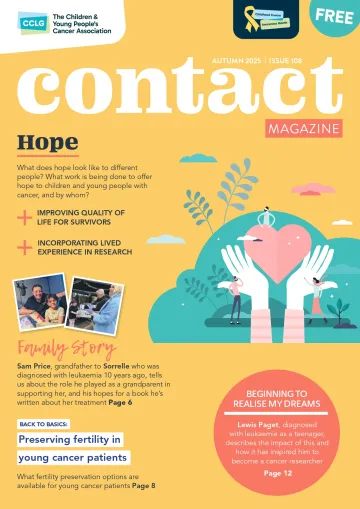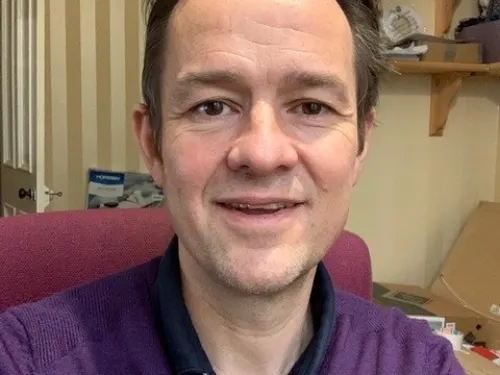Being told you, or your child, has cancer is hugely frightening, and naturally the first thought is usually about getting better. The future suddenly becomes uncertain, but discussions about diagnosis and treatment lead to consideration of long-term implications. While fertility may feel like something to worry about later, it needs to be thought about before any treatment starts. Follow-up studies of cancer survivors show that infertility is one of the most distressing long-term side effects, including feelings of regret at not trying to preserve fertility before treatment started.

Dr Mark Brougham

Dr Mark Brougham
Edinburgh Fertility Preservation team

Prof Rod Mitchell

Prof Rod Mitchell
Edinburgh Fertility Preservation team
What do we mean by infertility?
It’s important to consider what we mean when we talk about fertility. Boys who haven’t yet gone through puberty don’t make sperm that can fertilise an egg. However, their testes contain ‘spermatogonial stem cells’, from which sperm will be made when they’re older. These can be permanently damaged by some cancer treatments, which means they’ll never make enough sperm of their own. However, the cells in the testes that produce the male hormone testosterone are much less likely to be damaged. Therefore, they can go through puberty and grow normally, but may not be able to have a baby naturally.
Girls are born with all their eggs in their ovaries, and this ‘reserve’ goes down throughout life until menopause, when periods stop and no further eggs are released. The timing of menopause varies due to many different factors, including genetics. If your mother had an early menopause then you’re more likely to have one. The average age of menopause is around 51. Some cancer treatments cause the egg supply to go down faster than normal, which means menopause will occur earlier.
This might mean considering trying for a baby earlier in life, in case menopause occurs early. Some treatments cause the ovaries to stop working at a very young age, and therefore having a baby naturally may not be an option. An early menopause also results in other health issues, which can be helped by hormone replacement therapy (HRT).
The effects of treatment are difficult to predict so it’s very important not to assume fertility has been affected by treatment. Contraception should still be used if a pregnancy is not desired.
There are many ways to help assess fertility, but most are only helpful once puberty is finished. For males who have gone through puberty, measuring the volumes of their testes in clinic can be a good guide as to whether sperm are being made. Blood tests measuring hormone levels can also be useful. A sample of semen can be sent to the lab to analyse numbers of sperm and how well they move. If fertility hasn’t been significantly affected by previous cancer treatment, there shouldn’t be further decline.
For females who have gone through puberty, regular periods are a sign that the ovaries are functioning well. However, it can take time for periods to become regular after any chemotherapy. The volumes of the ovaries can be measured using an ultrasound scan and hormone levels in the blood can also be measured. Anti-Müllerian Hormone (AMH) can be a useful indicator of how many eggs are left, but it isn’t clear-cut and measurements before or during puberty can be difficult to interpret.
Discussing fertility at diagnosis
There are huge amounts of information to take on at diagnosis. Side effects of chemotherapy can feel overwhelming. However, when cancer survivors reflect on these discussions, many say the information they received on fertility wasn’t enough to help them, and their families, decide what to do. It’s therefore important that the healthcare team discuss fertility with patients and families. This should include what problems may happen and, particularly if there’s a high risk of infertility due to treatment, what can be done now that may help in the future.
Who’s at risk?
It’s important to remember that not all cancer treatments cause infertility. Radiotherapy that includes the testes or ovaries is particularly damaging, with a very high risk of future infertility and, for women, early menopause. Some chemotherapies cause very little damage to testes and ovaries, but others do cause infertility in later life. However, the amount of damage depends on the total dose given and can be very difficult to accurately predict. Your healthcare team should explain to you how likely future fertility will be affected, but it’s important to remember this represents a ‘best guess’ based on treatment, whereas other factors will also affect future fertility, such as genetics, diet and smoking.
Most of the evidence we have about cancer treatments and their effects on fertility come from follow-up studies, based on assessing fertility in people who have received these treatments many years ago. Increasingly, ‘newer’ treatments for cancer are being used, such as immunotherapy, which uses the immune system to treat cancer – for example, with antibody treatments and CAR-T, and enzymes targeting growth factors in cancer cells. Because these haven’t been given to children until relatively recently, we don’t yet know what effects these treatments may have.
What can be done?
For many, future fertility may not be at sufficient risk to justify performing procedures to preserve fertility, particularly if these require extra surgery. However, if fertility may be at risk, it’s very important to consider what can be done to protect or preserve fertility before any cancer treatment is given, otherwise, it might be too late. Cancer can cause symptoms that may be life-threatening, such as a tumour affecting breathing or the spinal cord, or may be affecting vision. In such circumstances, emergency cancer treatment may be essential, meaning fertility preservation isn’t possible.
Established techniques
For males who have gone through puberty and are able to produce a semen sample by masturbation, sperm can be stored before any cancer treatment, for future use. This is established and should be offered to all suitable patients. However, for some young patients who have just been told they have cancer, this can be difficult to do, and semen samples at this time often don’t contain enough healthy sperm.
For females who have gone through puberty and have a partner with whom they want to start a family, eggs can be produced from the ovaries and fertilised using the partner’s sperm by in vitro fertilisation (IVF). The embryos can then be stored and, in the future, put back into the womb. This can be very successful. For mature females who don’t have a partner, eggs can be produced and stored for future use, which is established but works less well than storing embryos. Unfortunately, both techniques require hormones to be given to stimulate the ovaries before eggs are harvested. This can take several weeks, which will delay cancer treatment. Because of this, it’s often not appropriate to consider this for young cancer patients.
Experimental techniques
Because ovaries contain eggs for the future, part or all an ovary can be removed with an operation before cancer treatment and stored for future use. This can be done at any age. This has been done for many years and has been successful, with babies born as a result. However, it remains experimental as we’re still learning how best to use the ovarian tissue, particularly when it’s taken before puberty. Surgery to get the tissue at the start is also significant and a lot to go through at a time when so much else is going on. The operation is usually done using a ‘keyhole’ approach, under the same anaesthetic as other procedures, such as putting in a central line.
Boys who haven’t yet gone through puberty don’t have any sperm to store but they have ‘stem cells’ in their testes. Taking a small piece of one of the testes may contain enough of these stem cells to store. In future, it’s hoped that sperm can be made from these stem cells, which can then be used to make a baby using techniques like IVF. However, this is very experimental, and no babies have been made in this way yet, but research is rapidly advancing so it’s hoped this will be successful in the future. Because this is experimental, it’s important it’s only done as part of a carefully monitored research programme and should only be offered to appropriate patients at very high risk of future infertility, with careful counselling and consent.
Sexual health
Survivors of childhood and young person’s cancer can have problems with different aspects of sexual health. It’s important to remember that fertility and sexual health are different. Your fertility may not be affected but you may have problems with sex, and equally you may have problems with fertility but no problems with sexual activity. These are issues that are important to discuss with your healthcare team.
From Contact magazine issue 108 | Autumn 2025





